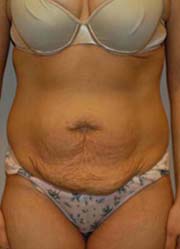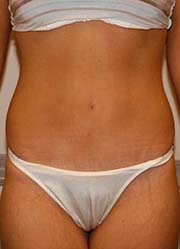Centrally located in Southampton, PA and serving Philadelphia, Bucks, and Montgomery Counties, The Kole Plastic Surgery Center performs tummy tucks for patients desiring plastic surgery.
Abdominoplasty or tummy tuck is a surgical procedure in which the excess skin of the abdomen is removed and the underlying abdominal muscles are tightened. If you have weak muscles after pregnancy or extra skin from weight loss, a tummy tuck may be for you. This is often accompanied by liposuction. A physical examination will determine whether you need a tummy tuck or liposuction.
Liposuction will remove subcutaneous fat—the fat under the skin—which will tighten the surrounding skin to a degree. However, if you have hanging skin, poor skin tone, or “stretch marks” on your skin, then liposuction will empty the fat from underneath the skin but the skin will not retract. To obtain a smooth contour, you will need excision of this extra skin. A tummy tuck is performed when you have excess skin and weak musculature.
Tummy tucks are performed mostly on women after they have completed having children. Men also often have these procedures done, most commonly after significant weight loss.


If musculature is weak both above the belly button and below the belly button, then a full tummy tuck is the option.
In this procedure, an incision is made in the pubic area and carried down through the skin to the level of the musculature and elevated to the level of the belly button, just as in the mini tummy tuck. However, in the fully tummy tuck the belly button is excised from the skin but left attached to your body. Then the skin is elevated all the way to the rib cage and breastbone. The muscles are tightened back to their original position with permanent sutures from the belly button down to the pubic area, and also from the breastbone to the top of the belly button.
In addition, the external oblique muscles are then also mobilized toward the midline and sutured. This leaves an “internal corset” type of permanent suturing.
The skin is then repositioned. In most cases, all the skin from the belly button down gets excised and a slightly longer bikini line scar is the result. The belly button is then brought out through a new incision in the tighter skin. Liposuction is also routinely performed with full tummy tucks to shorten the length of the scar.
Following either a full or mini tummy tuck, drains are placed for several days to remove the excess fluid that would otherwise accumulate between the muscle layer and underneath the skin.
Complications are uncommon, but they may include poor scarring, bleeding, infection, change in skin sensation, skin contour irregularities, fluid or blood accumulations under the skin, and other incidents. People who smoke and people with diabetes have a greater risk of skin loss and wound healing complications.
The aging process is unavoidable, but prudent use of cosmetic surgery can repair some of the damage to your appearance caused by the passage of years. It’s important to keep your expectations realistic. At the Kole Plastic Surgery Center Center, conveniently located in Southampton, PA, Bucks County, PA, we strive to make you happy with your appearance.
The price of a tummy tuck will vary depending on the extent of surgery necessary to achieve the desired stomach appearance.
The Kole Plastic Surgery Center Center accepts cash, check, and credit card (MasterCard®, Visa®, American Express®, Discover®) as acceptable forms of payment.
Financing is also available through CareCredit®, United Medical Credit and Advanced Care.
If you dream about having a toned, contoured midsection, yet cannot achieve the ideal abdomen with diet and exercise, you may be a good candidate for a tummy tuck. The procedure helps men and women in Southampton, PA, Philadelphia County, Bucks County, Montgomery County and surrounding areas of Bucks County, PA, who have tried to tighten their bellies on their own but had little success. Contact us today to schedule a personal consultation with board certified plastic surgeon, Dr. Kole, to discuss your tummy tuck options.

215-315-7655
Kole Plastic Surgery Center
We firmly believe that the internet should be available and accessible to anyone, and are committed to providing a website that is accessible to the widest possible audience, regardless of circumstance and ability.
To fulfill this, we aim to adhere as strictly as possible to the World Wide Web Consortium’s (W3C) Web Content Accessibility Guidelines 2.1 (WCAG 2.1) at the AA level. These guidelines explain how to make web content accessible to people with a wide array of disabilities. Complying with those guidelines helps us ensure that the website is accessible to all people: blind people, people with motor impairments, visual impairment, cognitive disabilities, and more.
This website utilizes various technologies that are meant to make it as accessible as possible at all times. We utilize an accessibility interface that allows persons with specific disabilities to adjust the website’s UI (user interface) and design it to their personal needs.
Additionally, the website utilizes an AI-based application that runs in the background and optimizes its accessibility level constantly. This application remediates the website’s HTML, adapts Its functionality and behavior for screen-readers used by the blind users, and for keyboard functions used by individuals with motor impairments.
If you’ve found a malfunction or have ideas for improvement, we’ll be happy to hear from you. You can reach out to the website’s operators by using the following email
Our website implements the ARIA attributes (Accessible Rich Internet Applications) technique, alongside various different behavioral changes, to ensure blind users visiting with screen-readers are able to read, comprehend, and enjoy the website’s functions. As soon as a user with a screen-reader enters your site, they immediately receive a prompt to enter the Screen-Reader Profile so they can browse and operate your site effectively. Here’s how our website covers some of the most important screen-reader requirements, alongside console screenshots of code examples:
Screen-reader optimization: we run a background process that learns the website’s components from top to bottom, to ensure ongoing compliance even when updating the website. In this process, we provide screen-readers with meaningful data using the ARIA set of attributes. For example, we provide accurate form labels; descriptions for actionable icons (social media icons, search icons, cart icons, etc.); validation guidance for form inputs; element roles such as buttons, menus, modal dialogues (popups), and others. Additionally, the background process scans all the website’s images and provides an accurate and meaningful image-object-recognition-based description as an ALT (alternate text) tag for images that are not described. It will also extract texts that are embedded within the image, using an OCR (optical character recognition) technology. To turn on screen-reader adjustments at any time, users need only to press the Alt+1 keyboard combination. Screen-reader users also get automatic announcements to turn the Screen-reader mode on as soon as they enter the website.
These adjustments are compatible with all popular screen readers, including JAWS and NVDA.
Keyboard navigation optimization: The background process also adjusts the website’s HTML, and adds various behaviors using JavaScript code to make the website operable by the keyboard. This includes the ability to navigate the website using the Tab and Shift+Tab keys, operate dropdowns with the arrow keys, close them with Esc, trigger buttons and links using the Enter key, navigate between radio and checkbox elements using the arrow keys, and fill them in with the Spacebar or Enter key.Additionally, keyboard users will find quick-navigation and content-skip menus, available at any time by clicking Alt+1, or as the first elements of the site while navigating with the keyboard. The background process also handles triggered popups by moving the keyboard focus towards them as soon as they appear, and not allow the focus drift outside it.
Users can also use shortcuts such as “M” (menus), “H” (headings), “F” (forms), “B” (buttons), and “G” (graphics) to jump to specific elements.
We aim to support the widest array of browsers and assistive technologies as possible, so our users can choose the best fitting tools for them, with as few limitations as possible. Therefore, we have worked very hard to be able to support all major systems that comprise over 95% of the user market share including Google Chrome, Mozilla Firefox, Apple Safari, Opera and Microsoft Edge, JAWS and NVDA (screen readers).
Despite our very best efforts to allow anybody to adjust the website to their needs. There may still be pages or sections that are not fully accessible, are in the process of becoming accessible, or are lacking an adequate technological solution to make them accessible. Still, we are continually improving our accessibility, adding, updating and improving its options and features, and developing and adopting new technologies. All this is meant to reach the optimal level of accessibility, following technological advancements. For any assistance, please reach out to
abdominoplasty philadelphia, philadelphia tummy tuck, tummy tuck philadelphia, panniculectomy philadelphia, tummy tuck doylestown, tummy tuck surgery philadelphia, abdominoplasty doylestown, tummy tuck bucks county